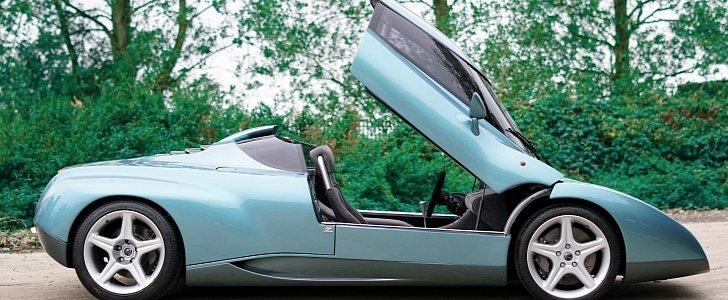A few years before the SVT division came up with the Ford F-150 Raptor, the Italians at Zagato launched a one-off with underpinnings from the Lamborghini Diablo VT. Revealed in the flesh at the 1996 Geneva Motor Show, the Raptor mid-engined supercar is currently looking for a new and caring owner at auction.
The bidding will start (and end) on November 30th in Abu Dhabi, and RM Sotheby’s describes the youngtimer as “a unique, modern coachbuilt supercar.” Nearly 300 kilograms lighter than the Diablo VT on which it’s based, the Zagato-designed model also features a viscous center differential for AWD.
The all-wheel drive is modified from the system that premiered in the LM002 “Rambo Lambo” from 1986, and VT stands for viscous traction. Up to 25 percent of the engine’s torque can be directed to the front wheels, and on the driving front, electronically adjustable dampers are highlights in their own right.
Lamborghini facelifted the Diablo VT in 1999, but the Zagato Raptor doesn’t feature the more powerful version of the 5.7-liter V12. The pre-facelift makes do with 492 PS (485 horsepower) and 580 Nm (428 pound-feet) of torque, and all told, close to 400 examples of the breed were built from 1993 to 1998.
The most striking design trickeries of the Raptor are the rear-hinged engine cover and the middle section of the car, a canopy that pivots forward to allow the driver and passenger to access the cabin. The double-bubble roof is beautified by a thumpin’ great air intake feeding the V12 in the middle, and the slippery design of the exterior allows for a top speed of approximately 200 miles per hour.
Zero to 60? Make that “less than four seconds,” thank you! “Lamborghini opted against putting the car into production” according to RM Sotheby’s, claiming that it’s too similar to the Canto that should have replaced the Diablo.
Codenamed P147, the Canto was scheduled to enter production but Ferdinand Piech wasn’t a big fan of the Zagato-designed exterior. Even with minor modifications to the intakes and bodywork, the Volkswagen Group eventually opted for the Murcielago as the last hurrah of the V12 developed by Giotto Bizzarrini in the 1960s with an original displacement of 3.5 liters.
The all-wheel drive is modified from the system that premiered in the LM002 “Rambo Lambo” from 1986, and VT stands for viscous traction. Up to 25 percent of the engine’s torque can be directed to the front wheels, and on the driving front, electronically adjustable dampers are highlights in their own right.
Lamborghini facelifted the Diablo VT in 1999, but the Zagato Raptor doesn’t feature the more powerful version of the 5.7-liter V12. The pre-facelift makes do with 492 PS (485 horsepower) and 580 Nm (428 pound-feet) of torque, and all told, close to 400 examples of the breed were built from 1993 to 1998.
The most striking design trickeries of the Raptor are the rear-hinged engine cover and the middle section of the car, a canopy that pivots forward to allow the driver and passenger to access the cabin. The double-bubble roof is beautified by a thumpin’ great air intake feeding the V12 in the middle, and the slippery design of the exterior allows for a top speed of approximately 200 miles per hour.
Zero to 60? Make that “less than four seconds,” thank you! “Lamborghini opted against putting the car into production” according to RM Sotheby’s, claiming that it’s too similar to the Canto that should have replaced the Diablo.
Codenamed P147, the Canto was scheduled to enter production but Ferdinand Piech wasn’t a big fan of the Zagato-designed exterior. Even with minor modifications to the intakes and bodywork, the Volkswagen Group eventually opted for the Murcielago as the last hurrah of the V12 developed by Giotto Bizzarrini in the 1960s with an original displacement of 3.5 liters.

























